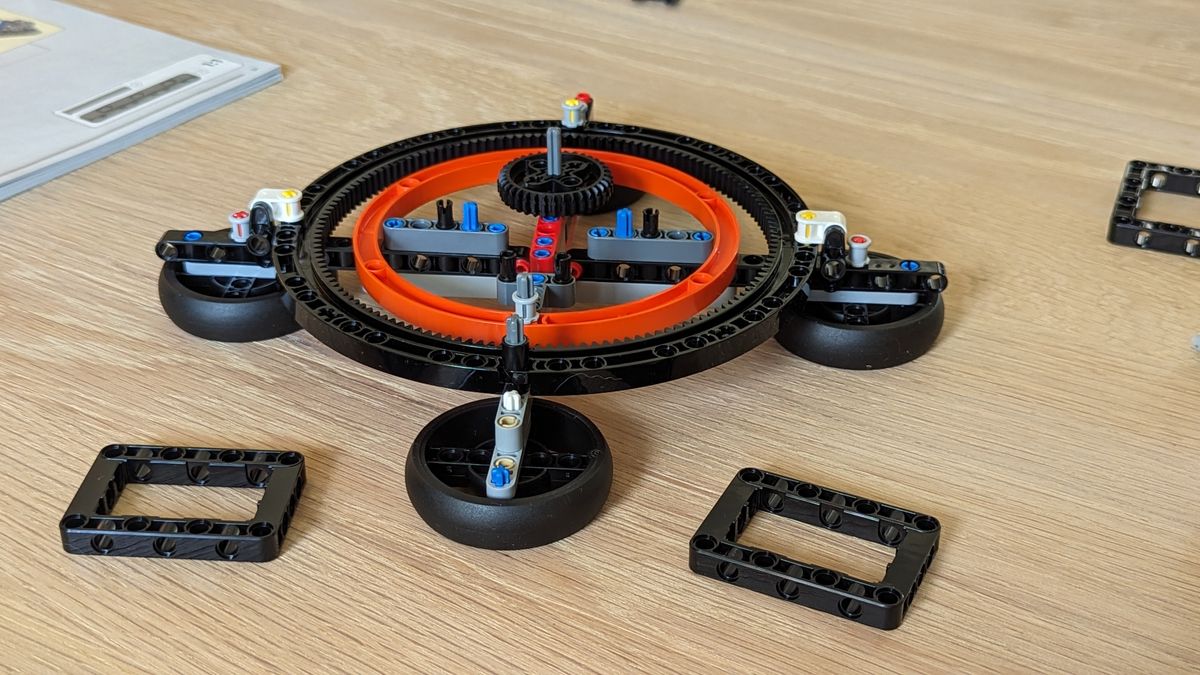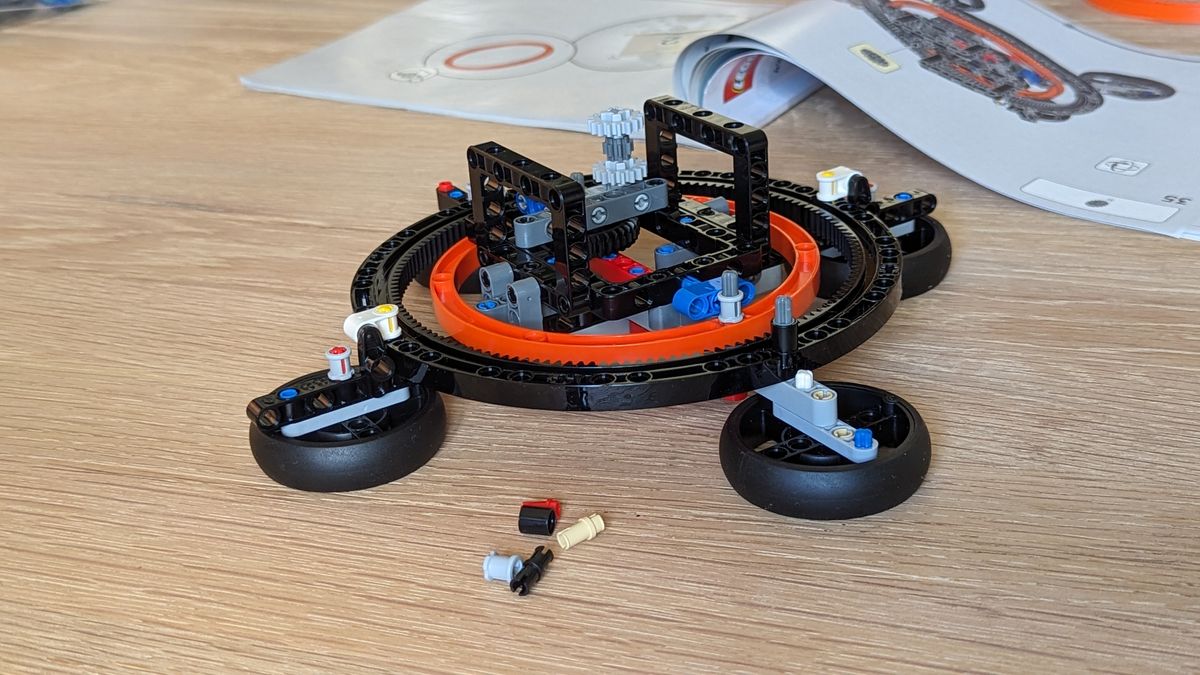Essential info:
Price: $74.99/£69.99
Model number: 42179
Number of pieces: 526
Dimensions (inches): 9 (H) x 12.5 (L) x 7 (W)
Recommended age: 10+
The Lego Technic planet earth and moon in orbit space set ticks all my boxes and then some. When I was looking for a model of the moon’s orbit around earth I first looked for fully-assembled scientific models that I could keep on my desk to show my young nephews.
But after a little internet sleuthing, I realized many of these models are fragile, large and cumbersome to younger space scientists. So naturally I turned to Lego. This 526-piece Technic set does several things absolutely amazingly. The set is full of gearing that must be accurately but easily assembled, with shafts and spindles that rotate, all basic engineering knowledge that is fun to acquire (at any age, I might add!).
Next, the set itself is quite accurate. No, it’s not the perfectly-to-scale model I was looking for at the beginning, but that was never really feasible for keeping in the home anyway. With a crank of the handle the earth orbits the sun, and the moon round the earth too, but the sun also revolves and so mimics the real-life movements. A month sticker wraps around the circular base and a handy indicator shows where you are in the year, to help explain why summer and winter comes to the northern hemisphere when it does.
I bought this with my own money and I love it. It’s fun to put together on your own or as part of a group and better yet, it’s scientifically informative and beautiful at the same time.
Lego planet earth and moon in orbit: Build
- This 526-piece build is more complex than larger-piece sets
- Some pieces need to be looked at carefully
- A multi-night build for those that start late
This 526-piece build was so fun to do. It took a couple of us two nights in all because we started late on the first night and I’d recommend you split it, too. Not because I don’t believe in you, but because there are so many fascinating aspects to the engineering of each piece that I found myself stopping to study what each part was doing.
The instruction booklet is easy to follow but there are some fiddly little pieces in there that can be oriented one way or another. These orientations, for the large part, didn’t seem to make any operative difference but I enjoyed squinting at them all the same to keep visual consistency throughout the set. Which, if you’re a stickler for details, you’ll find yourself doing as well.
It comes with four sealed bags (labeled one through four) and comes with the sun, earth and moon shells and the feet separately contained in clear bags. The instructions are also broken up into four sections and meticulously demonstrate how to identify which piece you need according to a scale in the booklet. This was helpful for me because I spotted several near-identical pieces that had slight length differences.
I started by constructing the base, first by collating the pieces into shape, size and color and then sharing it with my fellow builder on the table. Working as a pair seemed to go fairly smoothly because we were able to pick up on any erroneous orientations fairly quickly, mostly spotting each other’s mistakes, which sped up the build.
I had at least two instances where some of the set had to be disassembled because we realized that we missed a piece and I’d encourage you to check each page carefully before moving on to the next. Doing this too many times can lead to frustration, especially as you build into the night and get more tired.
Getting those first pieces together on the base is really satisfying. A big part of the model is put together fairly soon and I could see it encouraged us to carry on. I would recommend starting and stopping on a new bag of pieces if you’re carrying this across multiple days or nights. Depending on how your brain works or what you have going on during the day, it might be a little complex to carry over half-done and it would be easy to forget exactly where you are.
As soon as I got the geared arm pieced together and assembled the earth, moon and sun shells the excitement levels pumped up massively. A small rotation of the handle slewed this whole set around in a satisfying (but quiet) whirr. Getting the stickers in place and finally seeing the moon orbiting the earth, and the earth revolving and also orbiting the sun was incredibly satisfying, but spotting that the sun revolved too was a welcome surprise.
Lego planet earth and moon in orbit: Design
- Accurate earth paint with clear geographic icons
- Month stickers and an indicator show clear orbit progression
- Moon phase stickers help convey how we see the satellite from earth
At just 9-inches tall and 12.5-inches wide it isn’t the biggest Lego set you can own by a long shot, but while it will fit on a bookshelf it probably won’t fully rotate without crashing into something. Therefore, I’d recommend keeping this on a work desk or similar.
The sturdy rubber feet keep the rotating set from shuffling across the table, which is important because as I rotated the handle I could feel a fair amount of torque running through the set’s gears. Picking up and moving this set is no problem despite its apparent fragility and even after moving it from room to room several times over the course of a few months, not a single piece has broken off.
I closely inspected the paint on the earth shells and was pleasantly surprised to see that they are quite accurate, able to pick out North America from Canada and I was even able to spot the UK. Polar caps are noted with white, more temperate landscapes with green and drier areas with a light tan sand color. Impressive stuff.
The moon is featureless but, considering it’s smaller than my little fingernail, I was expecting this. The sun is featureless too but, aside from some sun spots that always shift on the real thing, to our eyes it’s relatively accurate as well (please, never look directly at the sun).
Here’s how the set moves: The sun revolves in the center, the earth orbits the sun and revolves through its day, and the moon orbits the earth. The moon does not revolve. The earth is tilted on its axis to, seemingly, the same degree as in real life.
Aside from its engineering beauty the stickers and indicators are what really make this set stand out to me, and are the reason why I bought this over a scientific model. Around the orange circumference of the main base, I applied stickers with the months of the year. A gold indicator glides over the top to demonstrate at what point in the year the earth is orbiting relative to its tilted axis.
For example, I headed round to June and could see that the northern hemisphere was tilted towards the sun which is accurate because this is when the northern hemisphere experiences the summer solstice. A wind round through to December showed the southern hemisphere pitched toward the sun, again showing the summer solstice again but for the southern hemisphere (and winter solstice for the north).
Should you buy Lego Technic planet earth and moon in orbit?
I would 100% recommend you buy the Lego planet earth and moon in orbit space set. It’s an ideal price for a birthday or holiday gift, the build is fun and even better with more than one person, and it’s full of engineering assembly. To top it all off, it’s a fairly accurate working model of how the earth orbits the sun and how the moon orbits the earth and it looks fantastic.
In my experience it’s durable enough to be moved between rooms, light enough to pop on a shelf and is fun and informative right from the moment I opened the box to the second I show my nephews how it works. They even enjoy turning the handle even when they’ve had enough of their uncle rambling on about barycenters and ecliptics.
Other Lego sets to consider
The complex engineering side of this Technics set might not be for everyone, and that’s okay. In that case, we’d recommend you choose one of our other top recommended Lego space sets like the Lego Ideas Tales of the Space Age — a fantastic set that was first conceptualized by amateur Lego designers like you. Beautiful but wonderfully simple these space sets are uploaded to the Lego Ideas platform and then voted on by fans before becoming real-life Lego sets.
If that’s a little too simple for you though and you’re after a little bit of nostalgia why not have a go with the Lego NASA Space Shuttle Discovery set? We gave this one 4.5/5 stars, stating that it’s “A beautiful kit that’s not only fun to build, but zenful too. Yes, the Lego NASA Space Shuttle Discovery costs a bit more, but it’s worth it as you technically get not one, but two separate models (hello Hubble Telescope).” But be forewarned as it’s a rather large set to display.





